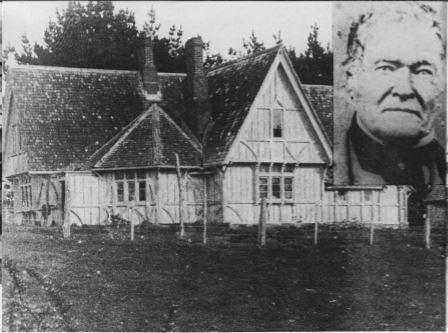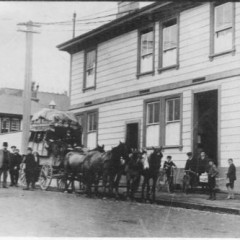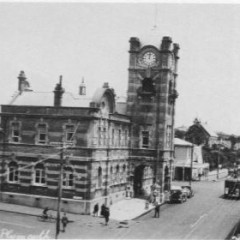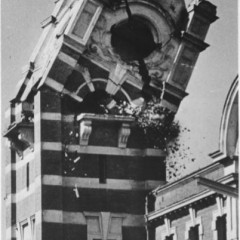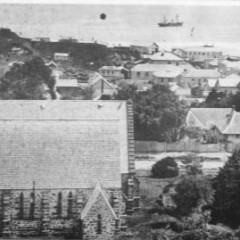8:3
tree. According to legend St Joseph of Arimathea travelled to England carrying a staff cut from the Crown of Thorns. The staff took root and Glastonbury Abbey was built near it. During a visit to England Govett took a cutting from the tree and planted it beside his vicarage. Botanical identification of the thorn is in conflict with the legend, but the Glastonbury origin of Govett's cutting is not in doubt.!" Govett built the vicarage at his own expense in 1860. This was moved across the street in 1901 to a block of land on the corner of Robe and Vivian Streets on which the present parish hall and the Peach Memorial Hall stand. The Govett family continued to live there. The present vicarage, a seven bedroom double-storey house still used by the incumbent, was built in 1901 for $2000 by Pickett and Grayling, and the first occupant was F. G. Evans, Govett's son-in-law. Other prominent churchmen who have served the Anglican persua- sion in New Plymouth include the Rev F. G. Evans (1898-1911), the Rev. A. H. Colville (1912-1917), the Rev. F. G. Harvie (1917-27), Canon E. H. Strong (1927-32), Archdeacon G. H. Gavin (1932-1949), the Rev. J. T. Holland (1949-1951), Canon W. E. W. Hurst (1951-1956) and Arch- deacon K. Liggett (1969-1977). Present incumbent is Archdeacon M. C. Bent. When Govett was ordained to the ministry in February, 1847, he was presented, as was customary, with a Bible by Bishop Selwyn. Inside the cover was his name, and a verse, in Govett's handwriting: 'Therefore God give thee the dew of heaven and the fitness of the earth-Gen. 27:28'. The book was kept on Govett's desk for many years, but some time late last century it disappeared. In 1937 the New Plymouth Borough Council required a Bible for a swearing-in ceremony. A clerk was sent to the nearby Methodist parsonage and borrowed one, which the minister said the council could keep. In 1941 the Bible was used again, this time to swear in some Home Guards, and the town clerk, glancing inside the cover, discovered its original owner. The Bible was rebound and presented to the Holy Trinity Church, Fitzroy, which had been built by Selwyn in 1845. For 70 years the Fitzroy area remained part of the parish of St Mary's, but in 1915 Holy Trinity was made a parochial district which included Bell Block. The district's first minister was a curate of St Mary's, A. H. Flavell. In 1950 Holy Trinity was elevated to the status of parish with M. Richards as its first vicar. Keeping pace with periodic extensions of borough boundaries the Anglican Church has extended its field of operations in the town. In 1952 Ornata, Moturoa and Westown were made separate pastoral districts within the parish.
The establishment of the Roman Catholic Church in Taranaki stems from two widely separated events-the great potato famine in Ireland which drove thousands of young men from their homeland, some to join the armed forces of Queen Victoria; and the disturbed relations (later to result in open hostilities) between Maori and Pakeha which brought the troops to Taranaki, where after long delays, they were provided with a resident priest. As early as 1852 the Marist Fathers had a Taranaki mission under the care of Father John Pezant who had arrived in the country in 1840. A year later Pezant visited Taranaki where he found no more than 40 Roman Catholics in the whole province. In letters discovered in the 1960s, Bishop Phillip Viard, first Bishop of Wellington who was appointed in 1850, refers to Father Pezant's visits to Taranaki at the time he was stationed at Wanganui. His primary concern was with Maoris and the care of a parish which extended from the Rangitikei River to the Mokau and beyond, prevented him from paying anything but brief and very infrequent visits to New Plymouth Pezant was a keen observer. His journeys were perforce alone and on foot, and he had to carry the necessities for Mass as well as his personal requirements. It was rough country, and many of the Maoris were already hostile to Europeans. He compiled a map of the route between Wanganui and New Plymouth which was later used as the 'official' map by the military forces stationed in the town. Viard's letters refer to the fact that Taranaki was without a visit from a priest between 1857 and 1859. This troubled the Irish troops, particularly those of the 65th Regiment who asked for a resident priest. Viard had to refuse: he had resident priests in Nelson, in Napier, in Wanganui and in the Hutt, where there were strong Roman Catholic followers, but there was no priest available for Taranaki until the arrival in 1859 of Father Maurice Tresallet, then aged 31, a Frenchman who knew neither English nor Maori. Viard sent him to Wanganui to serve under Pezant, and in February, 1860, he arrived in New Plymouth to found the mission which has served the area ever since. Tresallet's arrival characterised the unobtrusive devotion of the Marist brotherhood, and little notice was taken by 'the establishment'. Most of the early settlers arrived by ship and merited special mention of their names in the shipping and immigration notices in the Taranaki Herald and the Taranaki News. Tresallet received no such notice. 'There is, however, some ground for the opinion that the lack of Press notice of the Father's arrival was due rather to some influential local resentment of his presence; some two months later when he brought word to New Plymouth of the ambushing and mortal wounding of Mr Richard Brown near Waitara he was referred to in the Taranaki Herald simply as "a Roman Catholic clergyman", his name not being men- tioned. Some strange attitudes were taken in those pre-ecumenical days-and truth compels us to admit, not only by "our separated brethren"
Tresallet took up residence with the 40th Regiment, then stationed at Fort Niger. The regiment's commander, Colonel C. E. Gold, responded to Viard's plea that the new priest should be given every facility, and placed at his disposal one of the soldiers to act as his servant. The first Roman Catholic chapel, built in 1856 by men of the 65th Regiment in Courtenay Street on the site of the present New Plymouth Bowling Club's greens, was a modest affair, seating about 30 people. It was on land which had been given by the Provincial Government to the Catholic Mission, supplemented by a section given by Richard Brown, a New Plymouth merchant, no doubt in gratitude to Father Tresallet. The property was sold by the church in 1909. With the establishment of the barracks on Marsland Hill, this little chapel was too far away for the soldiers, and in spite of objections from Viard, who could not afford to pay $138 involved in buying some land on the present site of St Joseph's Church in Devon Street West, the troops-'shilling-a-day men' -raised the money, supplemented by other collections, and in 1862 they carried the tiny wooden structure on their shoulders to its new home, where additions were made to it. Tresallet, who by this time had mastered the English language-but the Maori language still baffled him-had not only to minister to the spiritual needs of the soldiers, but also had to look after other Europeans and their families. He established a part-time school for the children. This was the forerunner of the Catholic education system in New Plymouth. Tresallet was succeeded in late 1862 by Father Eugene Pertius, 'a very gentle character in the tradition of St Francis of Assisi' 17 for whom the strain and bloodshed in the war-torn province must have been particu- larly hard. He in turn handed over to Father Jean-Baptiste Rolland, hailed as a 'hero of New Zealand' and highly praised for his courage and devotion to duty by the famous bush-fighter, Major G. F. von Tempsky, during the attack on the stronghold ofTe-Ngutu-o-te-Munu in 1868, and on other occasions. Von Tempsky wrote: 'On a grey and rainy morning when our three hundred mustered silently in column on the parade ground, one man made his appearance who at once drew all eyes upon him in silent wonder. His garb was most peculiar; scanty but long skirts shrouded his nether garments; an old waterproof shirt hung loosely on his shoulder; weapons he had none, but there was a warlike cock in the position of his old broad-rimmed felt hat, and the self-confidence in the attitude in which he leaned on his walking stick that said "Here stands a man without fear" Who is it? Look underneath the flap of that clerical hat, and the frank, good-humoured countenance of Father Rolland will meet you ... Truly there stood a good shepherd ... 'Through the rapid river, waist deep, along weary forest track, across ominous looking clearings, where, at any moment a volley from an ambush would sweep our ranks ... and then, at last, in the clearing of Te-Ngutu-o-te-Munu, the storm of bullets burst upon us, he did not wait in the rear for men to be brought to him, but ran with the rest of us forward against the enemy's position.
So soon as any man dropped he was at his side. 'He did not ask "Are you a Catholic or Protestant?" but, kindly kneeling, prayed for his last words. Thrice noble conduct in a century of utilitarian tendencies.' Because of the fighting Rolland's duties as parish priest were only incidental to his task as military chaplain, but he found time to prepare plans for a new church and money to buy a section adjoining the old one. It was not until 1869 that he was able to devote more attention to the New Plymouth end of his large parish; he had buildings erected at Koru, near Oakura, where he founded the first monastic institution in New Zealand, and the first Catholic secondary school in Taranaki. To this end, with Bishop Viard's permission, he visited the West Coast goldfields, soliciting diggers' support for the monastery. The venture was short-lived. The monastery community became discour- aged at the lack of support following the death of Bishop Viard, and had disbanded by 1874. All that now remains are a few faint lines where buildings once stood, and indications of what could have been a cemetery. In New Plymouth Rolland enlarged the little church and as the congregation increased others were built on the same site-in 1875, 1898 and 1969. The present St Joseph's is a remarkable building. Dedicated by Cardinal McKeefry it stands above a reinforced concrete parish hall and is based on the principle of three symmetrically-placed arches; all hinged at their bases and whose crowns intersect a common point above, upon which a tower rears from a distinctive roof.
New Plymouth has had 11 parish priests-all dedicated men who have left their mark. Prominent among them were Father Chastagnon (1880-1884); Father Cassidy, the first Irish priest (1884-1889) who was responsible for building the first presbytery which did service until the present one was built in 1958; Father J. McKenna (1889-1922) and Father Lynch (1923-1925). Monsignor P. J. Minogue was the longest-serving parish priest, occupying that position from 1925 until the late 1960s when, because of failing health, he handed many of his administrative duties to Father Doogan. His many achievements included acquiring properties on which Catholic churches and presbyteries were built at Fitzroy, Brooklands and Barrett Road. He died in 1970. In 1978 Pope Paul VI made five priests of the Archdiocese of Wellington Prelates of the Papal Court. Four of them had associations with Taranaki: Monsignor T. A. Duddy, Monsignor J. Durham (both of whom had served as curates in New Plymouth), Monsignor Doogan, and the present Parish priest, Monsignor M. J. Carroll, who was appointed in 1971.
